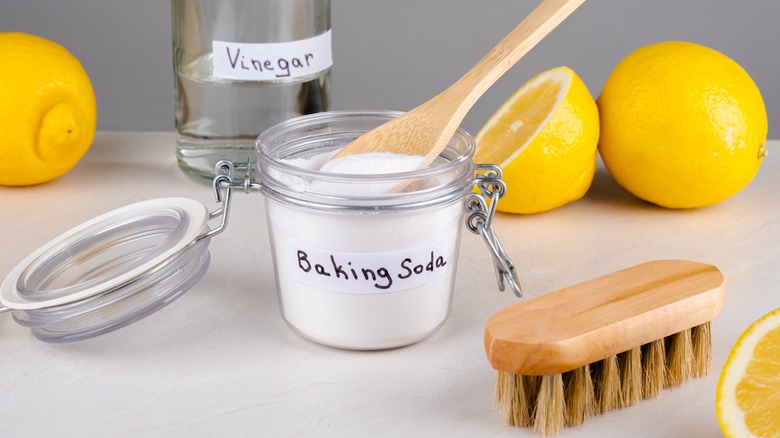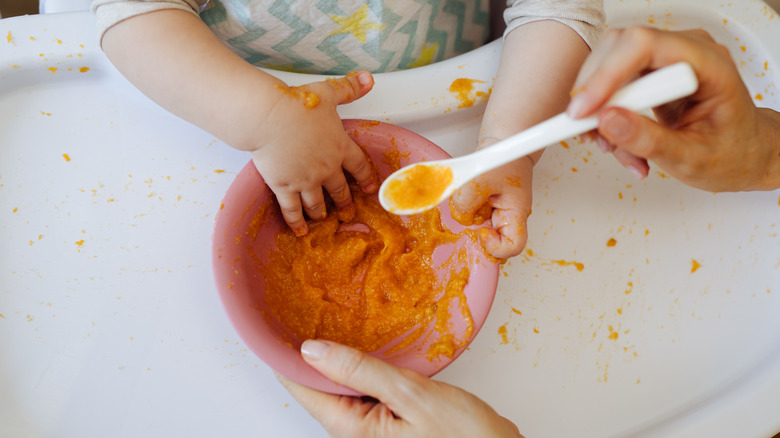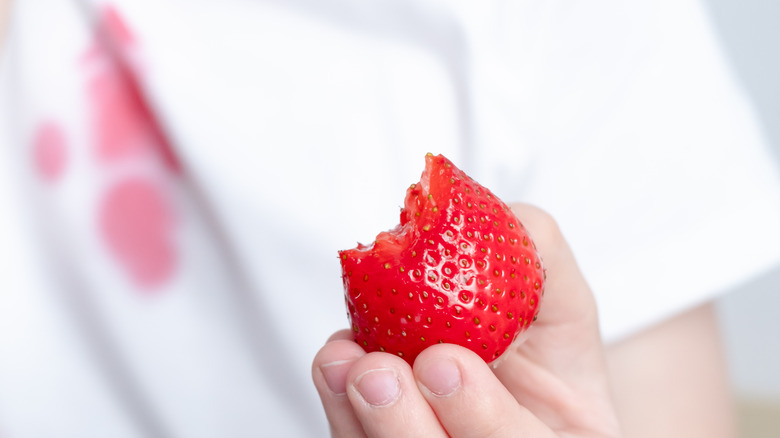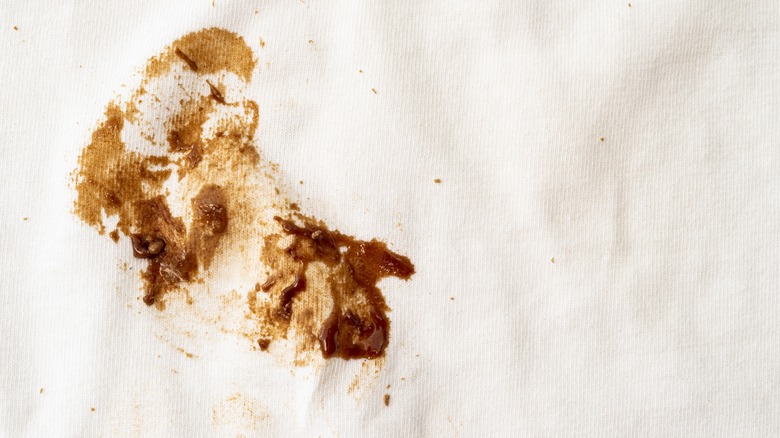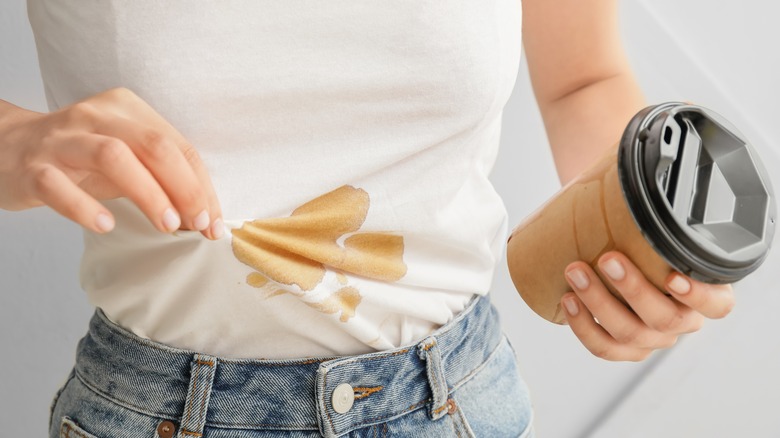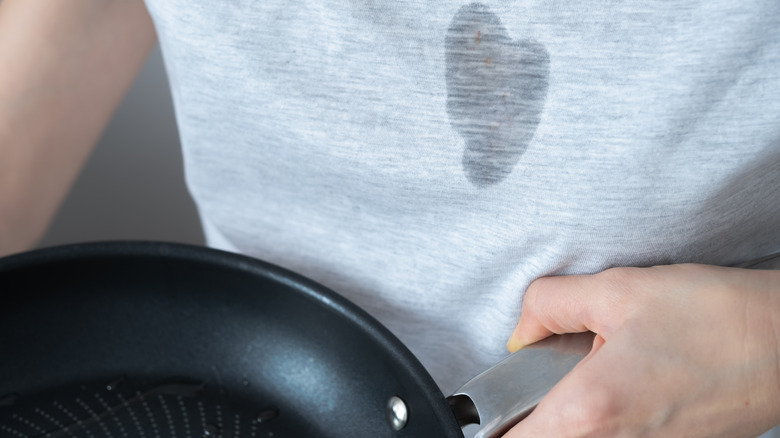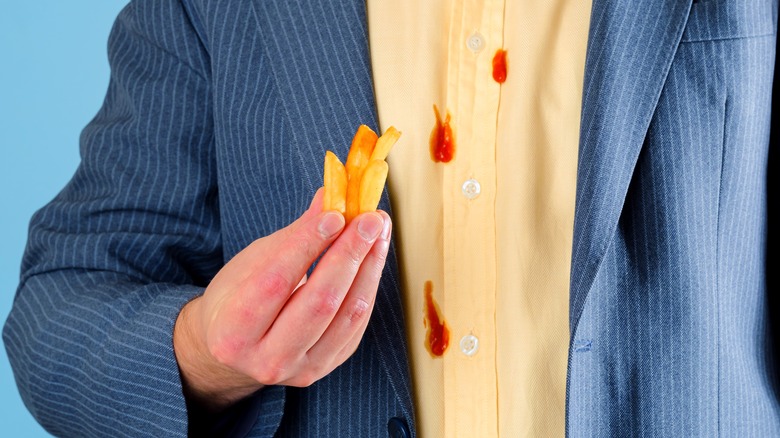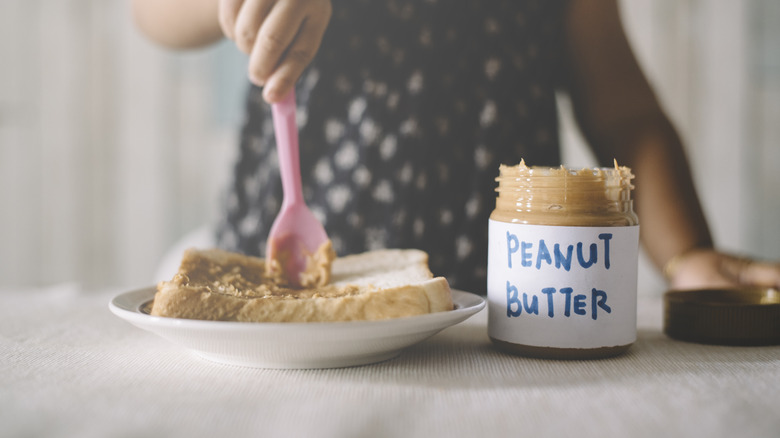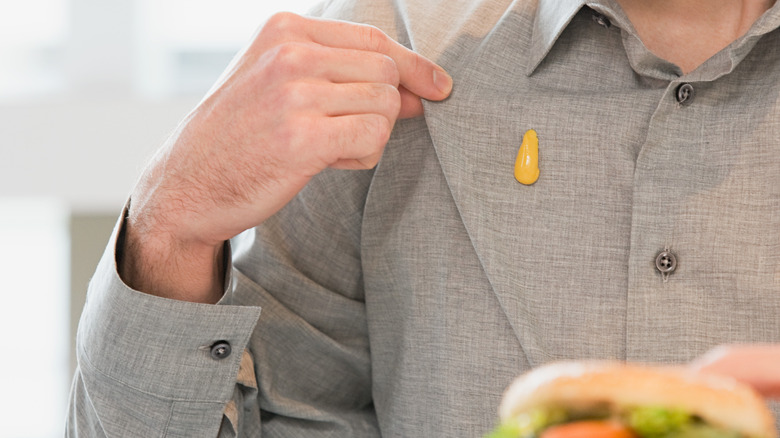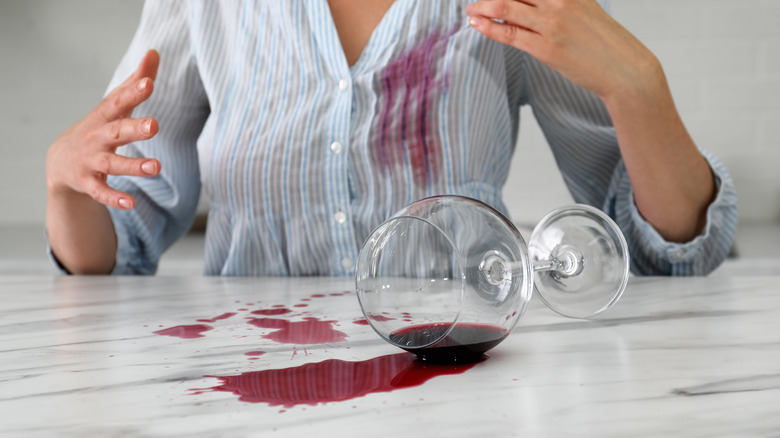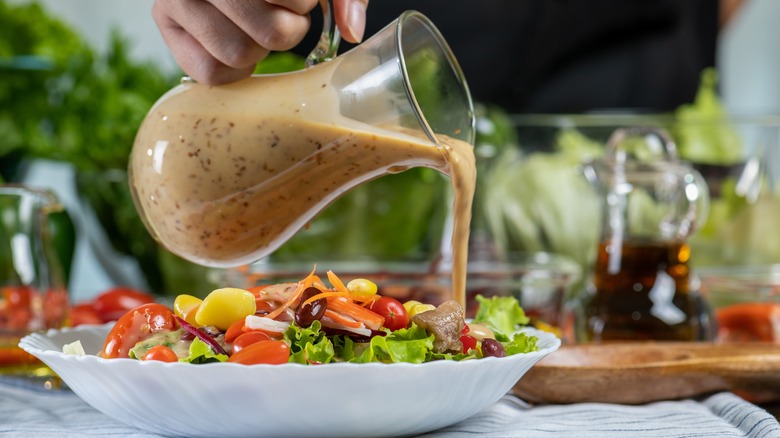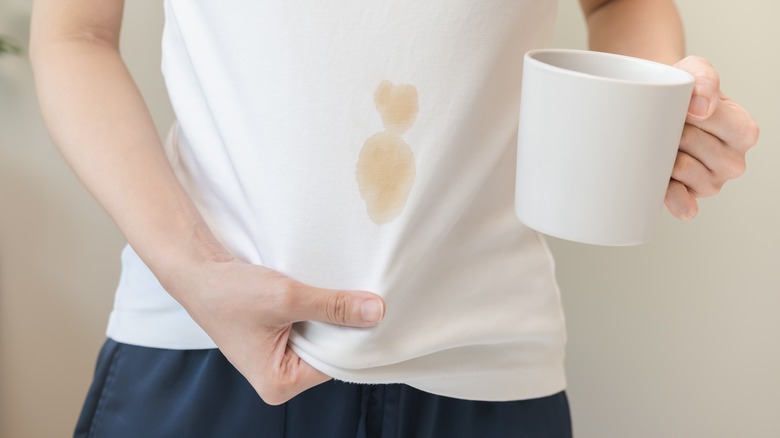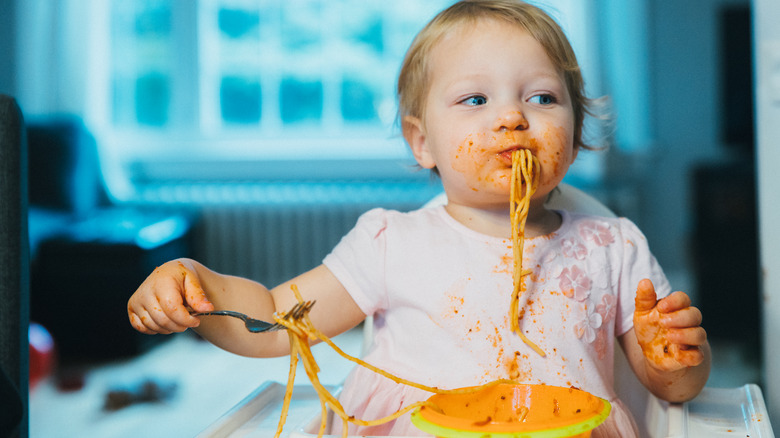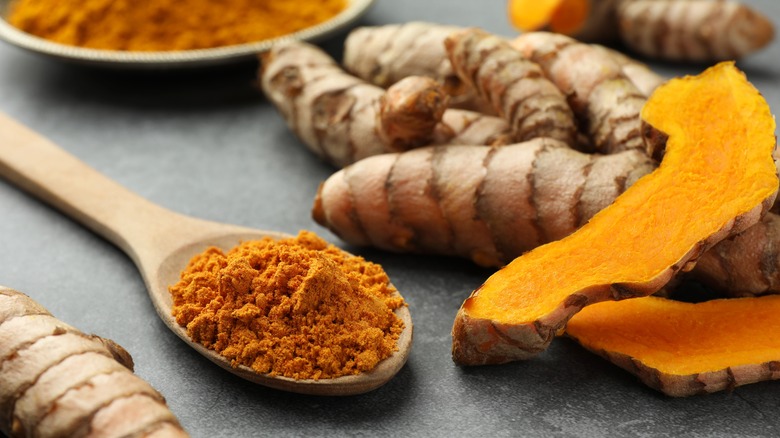13 Common Food Stains And How To Clean Them With Pantry Ingredients
Anyone who runs a household can tell you that food messes, like dishes, and clothes messes, like laundry, are the two types of messes that never end. Even the most well-organized household can get thrown into chaos when food messes become clothes messes. Food stains are some of the hardest to remove, up there with other frustrating stains like ink, blood, and grass. And if you have kids, or you're just a little bit clumsy, you may feel like you're battling food stains every day.
When food gets into fabric or carpet, removing the stains can feel like an insurmountable task. Luckily, there are plenty of strategies you can try to clean food stains. While heavy-duty stain cleaners are nice to have on hand, in many cases, they're not needed. Plenty of food stains can be removed with items from your pantry ... just be sure to keep plenty of baking soda and vinegar on hand!
1. Clean baby food stains with baking soda
Babies aren't exactly known for being the most coordinated creatures, and once feeding time is over, they're likely to have gotten food on their bibs, their clothes, their hands, their hair, and on whoever is feeding them. It would be nice if baby food companies could make a product that didn't stain so badly, but it seems they've got bigger things to worry about, what with heavy metals still present in popular baby foods.
The best way to remove baby food stains is to rinse the item under cold water right away. If the stain persists, make a paste of 4 tablespoons of baking powder and ¼ cup of warm water and rub that over the stain. Let it sit for a bit before tossing it in the wash. Baking soda is a great stain remover because it breaks apart organic compounds, is abrasive enough to dislodge the stain from the clothes, and dissolves in water.
For stains that have set in, try patting the stain with vinegar. Once it's damp, throw it in the wash. For whichever method you use, if the stain doesn't come out in the washing machine, don't put it in the dryer. Instead, repeat the method again. If the stain is still there after another run through the washer, you may need to move on to something more heavy-duty.
2. Clean berry juice stains with vinegar or lemon juice
Berries like strawberries, raspberries, blueberries, and blackberries, are the perfect refreshing treat for summer. Plump, juicy berries are a green flag to look for when buying produce because they indicate the fruit is ripe and ready for eating. The juiciness is part of what makes them so delicious! Unfortunately, that juice can create a stain that's ridiculously hard to get rid of.
To remove berry stains, try using vinegar. Vinegar is an excellent stain remover because it's pretty acidic, and acids react with the molecules in the stain, which causes the stain to pull away from the fabric. Soak the berry stain in vinegar for about an hour, then rinse and hang out in the sun to dry. The sun helps lift the stain away and also helps get rid of the vinegar smell. For extra-stubborn stains, mix the vinegar with some laundry soap, let it sit, then rinse with cold water and wash like normal.
Lemon juice is another great option to remove berry juice. It's just as acidic as vinegar, so it works in a similar way. Pour freshly squeezed lemon juice over the stain and let it sit for about half an hour. Then, dab the stain with a towel while pouring hot water over it. Once you get the stain out, rinse the area with cold water and toss it in the laundry.
3. Clean chocolate stains with baking soda
Chocolate is a delightful treat that's centuries old. It's used around the world to make chocolate candy, bake cakes, cookies, and brownies, and drink as hot chocolate. However, despite chocolate's many fabulous qualities and uses, it can leave quite a stain on clothes, upholstery, and carpet.
The first thing you should do to treat a chocolate stain is to scrape off any excess chocolate with the smooth side of a butter knife or something similar. Take care not to damage the fabric or to end up rubbing the stain in more. Next, use cold water to flush the stain out, alternating between the front and back of the fabric to dislodge it. If you still see a stain, or if the chocolate left an oily residue behind, it's time to bring out the baking soda.
Gently rub both sides of the damp stain with baking soda. This loosens the remaining chocolate and helps absorb any leftover oil. Then, wash as usual, but don't toss it in the dryer if the stain remains. For older, set-in stains, soak the fabric in a mixture of cold water and a cup of white vinegar for half an hour, then use a soft-bristled brush on the stain. Once it's gone, wash the fabric like normal.
4. Clean coffee stains with sparkling water
Coffee is a treat for some and a necessity for others, but the major downside to coffee is that it's a liquid. This means it's easy to spill, and unfortunately, coffee stains can be a pain to remove. Whether you've made it in a coffee machine or stopped on your morning commute, your coffee will leave a dark stain on fabric if it spills.
Like most stains, the faster you can start cleaning the coffee stain, the better. One of the best ways to remove coffee stains is by using sparkling water or club soda. Put the sparkling water in a spray bottle and spray the stain, then blot it with a cloth, starting at the outside of the stain and working inwards. Once the stain looks like it's gone, rinse with water.
This method works because the carbonation helps lift the stain away from the fabric. If a spray bottle isn't handy, you can wet a cloth with the sparkling water and dab it on the stain instead. Either way, be careful not to rub too hard and damage the fibers!
5. Clean grease stains with baking soda
Grease stains are some of the most frustrating stains to remove, not just out of food stains, but in general. Oil and grease soak into fabrics, leaving behind a dark stain. Since oil isn't water-soluble, basic washing won't get it out. You need a way to absorb the oil and break apart the bonds.
Start by using baking soda. Baking soda is excellent at absorbing excess oil, and can even be used to dispose of used cooking oil. Gently rub the baking soda into the grease stain to help it soak up and lift away oil. If you're out of baking soda, cornstarch works for this as well.
Depending on how bad the stain was, you may still have some residual grease left in your fabric. In this case, grab some dish soap. Most dish soaps are designed to fight grease, making them excellent for oil stains. Pour just a little bit over the stain and work it into the fabric with your fingers, then wash it as normal. Don't toss it in the dryer if the stain remains, and instead repeat the baking soda and dish soap.
6. Clean ketchup stains with an acid
Any sort of tomato-based stain is a pain to clean, and ketchup is no exception. This is because tomatoes are both brightly colored and full of tannins, which are compounds commonly used as dyes. Tannins are present in many foods, but the rich red of tomatoes means the stain can be extra hard to remove.
Ketchup is made with tomatoes, spices, sugar, and vinegar, and as a result, is slightly acidic. To remove ketchup stains, you'll need something that's even more acidic, like white vinegar or lemon juice. First, scrape away any excess ketchup, then blot the stain with a cloth or towel. Next, pour your lemon juice or vinegar over the stain and let it sit for about five minutes before rinsing.
If the stain remains, you can try this method again before tossing it in the wash. For particularly stubborn stains, you may need to go beyond the pantry and use an enzyme-based stain remover. Remember, don't throw the fabric in the dryer until you're sure the stain is gone.
7. Clean peanut butter stains with cornstarch and vinegar
Peanut butter is beloved by kids and adults alike and is great for snacking, sandwiches, and baking. This also means that there are plenty of opportunities for peanut butter to create stains on clothes, carpets, and furniture. When it comes to peanut butter stains, the color isn't what you need to worry about. It's the grease.
Peanut butter is greasy — there's a reason the word "butter" is in the name! While that grease can be helpful in baking or when you need to get gum out of your hair, it also means that when you wash out peanut butter, you'll likely find a grease stain left behind. Luckily, we've already given you a rundown of how to remove grease stains.
Scrape away any extra peanut butter first, then apply cornstarch or baking soda to soak up as much oil as possible. Then, work dish soap into the stain to help break up the oil. For areas like carpet that can't be rinsed, mix up a solution of two cups of warm water, 1 tablespoon of dish soap, and 2 tablespoons of white vinegar. Blot it onto the stain, then wipe away excess with a clean, damp cloth and let it air dry.
8. Clean mustard stains with vinegar
Mustard and ketchup go hand-in-hand, and both also cause major stains on fabrics. There are a few different kinds of mustard, but all of them have mustard seeds as a base. Most also include an ingredient like vinegar as well as turmeric, a spice known for dying things yellow. As a result, mustard can be a tricky stain to remove.
Out of all pantry items, vinegar is the best bet to remove mustard stains. First, scrape away any excess mustard, then mix up a solution of one part vinegar to two parts water and use a cloth or spray bottle to soak the stain. Let the stain soak about 10 minutes before blotting with a paper towel, then run it through the wash on the hottest setting your garment will allow. The faster the stain is treated, the easier it will be to remove.
For stains that are really set in or particularly stubborn, stronger cleaning products may be needed. Check the stain before you toss it in the dryer; if it's still there, try a stain remover instead. Don't put it in the dryer until the stain is completely gone.
9. Clean red wine stains with salt
Red wine has a similar problem to coffee: It's a great drink, but because it's a liquid, it's easy to spill. Red wine is notorious for leaving stains on fabrics (and teeth). This is partially due to the pigments in the grapes used for red wine, and partially because red wine is another food item with tannins in it. There are many types of red wine, and while some stain more than others, pretty much all are going to leave a stain behind.
Many people swear by using salt to remove red wine stains. First, blot out as much of the wine as possible with a clean cloth. Then, put cold water over the stain and cover the area with salt; either regular table salt or kosher salt will do just fine. Leave the salt on for at least five minutes. If the stain is particularly tricky, you can leave it on overnight. Rinse with cold water and repeat if needed. Once the stain is gone, wash the fabric in cold water.
Another option is to swap the salt for baking soda. For stains on places like carpet or furniture that you can't toss in the washing machine, try a mixture of one part baking soda to three parts water, or ¼ tablespoon baking soda and 1 tablespoon white vinegar. Cover the stain and let it air dry, then blot. Repeat as needed.
10. Clean salad dressing stains with baking soda
Salad dressing is key for adding a burst of flavor to salads, but it can also be used for dipping and for cooking. Although there are several types of salad dressings, most of them have an oil and vinegar base, and many have ingredients like egg yolks, buttermilk, and a range of herbs and spices. While these herbs and spices may cause staining, the biggest issue with salad dressing is the oil.
Like peanut butter, salad dressing leaves an oily residue behind on fabrics. It probably comes as no surprise, then, that salad dressing stains need to be treated in a similar manner to peanut butter stains. Start by removing excess dressing, then attack the stain with baking soda or cornstarch to absorb the oil.
Leave it on for at least 30 minutes, then rinse and massage with dish soap before rinsing again. You can also try leaving the baking soda on and pouring vinegar over it, letting the reaction work to break apart the oil. Rinse and run through the wash, but don't put it in the dryer if the stain is still there.
11. Clean tea stains with baking soda or vinegar
Tea joins coffee and wine in the category of "easy to spill, easily stains." This is again thanks to tannins, which are present in all types of tea in some amount. While stain removers work best to combat tea stains, baking soda and white vinegar work as well, especially when the stain is still wet.
To use baking soda, cover the entire stain with a thick layer of the powder to absorb the tea. Leave the baking soda on overnight, then scrape the powder off and rinse. If there's any stain left, toss it in the wash with some detergent. Remember, don't dry it if the stain remains, and use a stain remover instead. A paste of baking soda and water also works great to remove tea stains from mugs. Let the paste sit for about ten minutes, then rinse.
When using vinegar, apply the vinegar directly to the stain and let it soak for at least half an hour. Finally, rinse and send it through the washer to get rid of any lingering vinegar smell. For carpet and upholstery, mix a solution of 1 tablespoon dish soap, 1 tablespoon of vinegar, and 2 cups of cold water. Dab this on the stain until it's saturated, then blot with a clean cloth.
12. Clean tomato sauce with vinegar or salt and baking soda
Tomato sauce has the same problem ketchup has: It's made with tomatoes, which stain. Unfortunately, many types of tomato sauce are also greasy, especially when there's meat involved. This creates a double whammy when it comes to stain removal but the super team of vinegar, baking soda, and salt are here to help again.
The first method for removing tomato sauce requires vinegar, dish soap, and ice. After removing the excess sauce, spread dish detergent over the stain and rub it with an ice cube. Then, blot the stain with vinegar using a clean cloth. Rinse and wash as usual.
For method number two, all you need is salt and baking soda mixed together in equal amounts with a little bit of water to make a paste. Remove any excess sauce, then spread the paste over the stain and massage into the fabric. Finally, toss it into the laundry and wash like you normally would.
13. Clean turmeric stains with alcohol, vinegar, or baking soda
As we mentioned earlier, turmeric is a spice. It's in the same family as ginger, and is often used in Indian, Middle Eastern, and Caribbean dishes. Dried turmeric has a citrusy, peppery taste and a vibrant orange hue that can stain clothes, hands, and dishes. Luckily, there are a few ways to get rid of the staining.
Alcohol is one option that tends to work really well to remove turmeric stains. Choose a clear alcohol, like vodka, isopropyl alcohol, or even hand sanitizer, and spot treat the stain. Then, use a clean cloth or soft sponge to dab the fabric until the stain is gone. You can also mix together 1 tablespoon dish soap, 1 tablespoon white vinegar, and about 2 cups of cold water. Apply the solution with a clean cloth or sponge.
Vinegar also works to clean dishes. Let the dish soak in a mixture of two parts warm water and one part vinegar, plus a few drops of dish soap, for 15-30 minutes. For countertops, make a paste of equal parts baking soda and water, cover the stain, and let it sit for about 15 minutes. You can also add some vinegar or lemon juice to create a reaction, so long as your countertop isn't natural stone. A paste of equal parts lemon juice and baking soda works great to remove turmeric from the skin as well.
